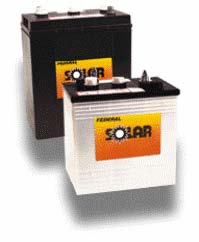HOME SOLAR POWER BATTERY MAINTENANCE
DEPENDING ON THE TYPE OF BATTERY YOU ARE USING IN YOUR HOME SOLAR SYSTEM IT IS IMPORTANT HOW YOU LOOK AFTER THEM IF YOU WANT THEM TO LAST THE MAXIMUM AMOUNT OF TIME AS EXPECTED IN YOUR BATTERY MANUFACTURERS SPECIFICATIONS.
Just about all Home Solar Batteries are deep cycle and most can be expected to last 25 or more years but that service life can be severely reduced as these batteries are deep – cycle which means they have to be cycled from fully charged to almost 80% discharged ON A REGULAR BASIS. Misuse of your batteries can see the service life severely reduced to almost a third. We have seen batteries almost dead after only seven years both from undercharging and overcharging
BATTERY CHARGING
BATTERY CHARGING TAKES PLACE IN 3 BASIC STAGES: Bulk, Absorption, AND Float.
Bulk Charge (Boost) - The first stage of 3-stage battery charging. Current is sent to batteries at the maximum safe rate they will accept until voltage rises to near (80-90%) full charge level. Voltages at this stage typically range from 10.5 volts to 15 volts. There is no "correct" voltage for bulk charging, but there may be limits on the maximum current that the battery and/or wiring can take.
Absorption Charge: The 2nd stage of 3-stage battery charging. Voltage remains constant and current gradually tapers off as internal resistance increases during charging. It is during this stage that the charger puts out maximum voltage. Voltages at this stage are typically around 14.2 to 15.5 volts.
Float Charge: The 3rd stage of 3-stage battery charging. After batteries reach full charge, charging voltage is reduced to a lower level (typically 12.8 to 13.2) to reduce gassing and prolong battery life. This is often referred to as a maintenance or trickle charge, since it's main purpose is to keep an already charged battery from discharging. PWM, or "pulse width modulation" accomplishes the same thing. In PWM, the controller or charger senses tiny voltage drops in the battery and sends very short charging cycles (pulses) to the battery. This may occur several hundred times per minute. It is called "pulse width" because the width of the pulses may vary from a few microseconds to several seconds. Note that for long term float service, such as backup power systems that are seldom discharged, the float voltage should be around 13.02 to 13.20 volts.
Chargers: Most garage and consumer (automotive) type battery chargers are bulk charge only, and have little (if any) voltage regulation. They are fine for a quick boost to low batteries, but not to leave on for long periods. Among the regulated chargers, there are the voltage regulated ones, such as Iota Engineering and Todd, which keep a constant regulated voltage on the batteries. If these are set to the correct voltages for your batteries, they will keep the batteries charged without damage. These are sometimes called "taper charge" - as if that is a selling point. What taper charge really means is that as the battery gets charged up, the voltage goes up, so the amps out of the charger go down. They charge OK, but a charger rated at 20 amps may only be supplying 5 amps when the batteries are 80% charged. To get around this, Stat power (and maybe others?) have come out with "smart” or multi-stage chargers. These use a variable voltage to keep the charging amps much more constant for faster charging.
Do you want to design, install or build your very own solar powered home, but don't know how or where to start? Get DIY solar power guide that includes tips for Australia solar power conditions!
Not doing DIY solar power? Don’t let your solar contractor hoodwink you! Learn the tech info so that you can negotiate your best deal and make sure what you buy suits your needs.
DIY Solar Power for Homes Online Guide
P.S. Liked this post? Be a sharer and spread the word on FaceBook or Twitter or G+.
And I'd love to hear your views or suggestions too! Just click the Comments link below and tell us your story - Thanks!
Join in and write your own page! It's easy to do. How? Simply click here to return to Going Green.

"Power Tips" magazine is back!
You Get A Free Complete Self Help Report delivered to your email box every edition, plus you get a free PLR article and other great gifts!
SUBSCRIBE BELOW ... I promise you will want to USE what you learn!
I really want to know what you think of this site, this page, and to hear your tips or suggestions about it.
So please share your story or simply add a Comment in the comment box.
If you feel that the information on this page has been useful to you please give it a Like or share it with your friends - thanks!!
"You are a life Saver!!
I recently discovered this site and I can tell you that my life has not been the same. I now come here EVERYDAY and spend at least 1 hour.
I used to spend that time browsing online fashion and beauty
magazine which just means that I spend more. Now I have replaced that
habit with coming here.
In future I will think about contributing articles as well. Thank you! Thank you!! Thank you!!! and God bless"
Contact Us | About Us | Terms of Use | Privacy Policy | FAQ | Testimonials
Amazon and the Amazon logo are trademarks of Amazon.com, Inc. or its affiliates. As an Amazon Associate I earn from qualifying purchases. Product prices and availability are accurate as of the date/time
indicated and are subject to change. Any price and availability
information displayed on [relevant Amazon Site(s), as applicable] at the
time of purchase will apply to the purchase of this product.









